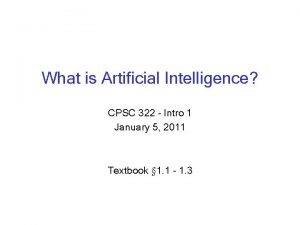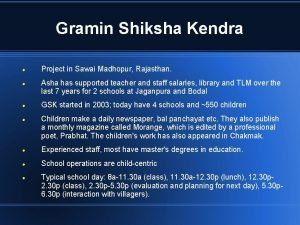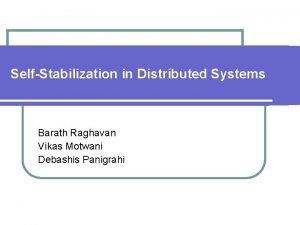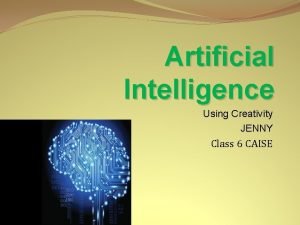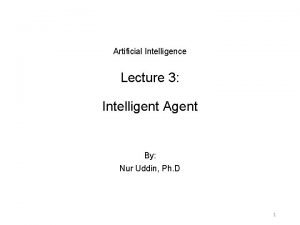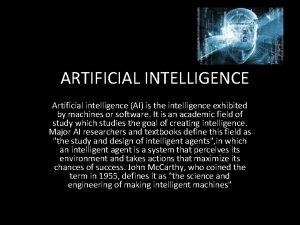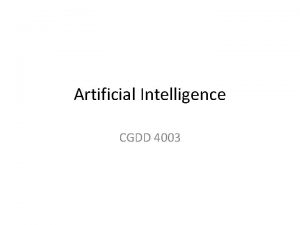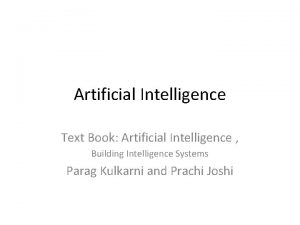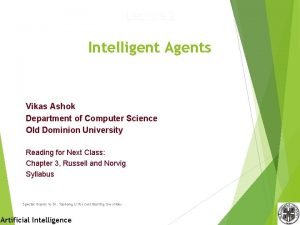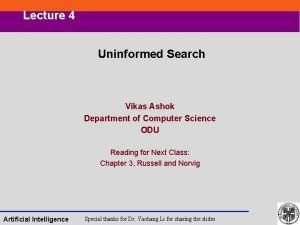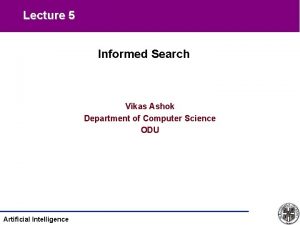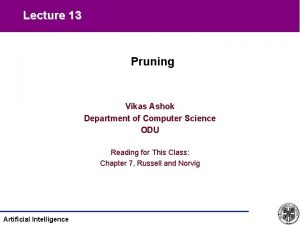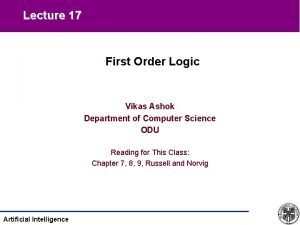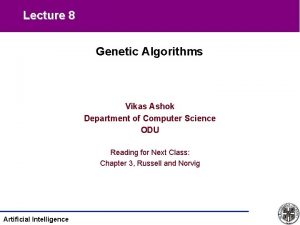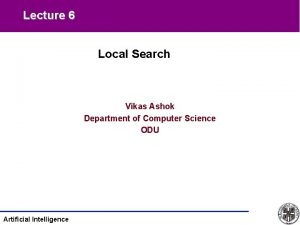Introduction to Artificial Intelligence Vikas Ashok Department of








































- Slides: 40

Introduction to Artificial Intelligence Vikas Ashok Department of Computer Science Old Dominion University Reading for Next Class: Chapter 1, Textbook Syllabus Special thanks to Dr. Yaohang Li for sharing the slides Artificial Intelligence

Course Outline • Overview: Intelligent Systems and Applications • Artificial Intelligence (AI) Topics – – – Intelligent agent Problem Solving • Classical search • Game tree search • Constraint Satisfaction Problem Knowledge Representation • Logic and inference Learning • Supervised and unsupervised learning Advanced topics • Genetic Algorithms • Artificial neural network • Natural Language Processing • Vision Processing Artificial Intelligence

Administrivia • Class Web Page – https: //www. cs. odu. edu/~vashok/ (Go to “Teaching” Tab) – Instructional E-Mail Addresses – vganjigu@odu. edu • Instructor: Vikas Ashok – Office phone: 757 -683 -7797 – Office location: 3107 E&CS – Office hours: • Tuesdays, Thursdays: 4: 15 PM-5: 15 PM • by appointment Artificial Intelligence

Administrivia Grading Policy (5+) Assignments 50% Late Assignment Policy (without a valid reason) 0~24 hrs: -5% 24~48 hrs: -10% >48 hrs: grade = 0 (1) Midterms: 25% (1) Finals: 25% Artificial Intelligence

Administrivia Textbook Artificial Intelligence, 3 rd Edition, by Stuart Russell and Peter Norvig Artificial Intelligence

Honor Code All assignments, unless explicitly specified, are to be completed on your own ODU Honor Council http: //orgs. odu. edu/hc/ Evidence of cheating, plagiarism, or unauthorized collaboration will result in a 0 grade for quiz/assignment/exam May have further consequences Artificial Intelligence

How to get help? Ask questions in class (or after class) Attend office hours Email me Make sure that you put “CS 480” or “CS 580” in your subject line Send it from your. odu. edu account It wouldn’t come to my spam folder State clearly what you need in your email Artificial Intelligence

How To Get an A in This Course • Attend Classes • Review Class Notes and Books – Review class notes – Review book chapters • Be Aware of Resources – Check with the course website about • Handouts, lectures • Resources online – Check with classmates about material from missed lecture • Start working on your assignment early – How to start virtuous (as opposed to vicious) cycle – How not to cheat Artificial Intelligence

About Me Master’s from ODU. Ph. D. from Stony Brook University Postdoc at Stony Brook University [Re-]Joined ODU in Fall 2019 My research Human Computer Interaction Natural Language Processing and Machine Learning How about you? Name/Year/Major Something interesting about yourself Expectation from this course Artificial Intelligence

What is AI? • Categories of Systemic Definitions – – 1. 2. 3. 4. Thinking like a Human Acting like a Human Thinking Rationally Acting Rationally • Thinking Like a Human – Machines with minds (Haugeland, 1985) – Automation of “decision making, problem solving, learning…” (Bellman, 1978) • Acting Like a Human – Functions that require intelligence when performed by people (Kurzweil, 1990) – Making computers do things people currently do better (Rich and Knight, 1991) • Thinking Rationally – Computational models of mental faculties (Charniak and Mc. Dermott, 1985) – Computations that make it possible to perceive, reason, and act (Winston, 1992) • Acting Rationally – Explaining, emulating intelligent behavior via computation (Schalkoff, 1990) – Branch of CS concerned with automation of intelligent behavior (Luger and Stubblefield, 1993) Artificial Intelligence

Thinking Like a Human: Can Machine Think? Goal of Artificial Intelligence Make machines do things that would require intelligence if done by humans Can machines think? Vitally important But “thinking” is hard to define No simple answer of “Yes” or “No” A fuzzy answer Artificial Intelligence

Turing Test Can a machine pass a behavior test for intelligence? Turing Test: can a machine appear indistinguishable from a human to an experimenter? Artificial Intelligence

Eugene Goostman Turing predicted that by year 2000, computers would be intelligent enough to trick humans into thinking they were real 30% of the time. Eugene Goostman A Chatterbot Portrayed as a 13 -year old Ukrainian boy On June 7, 2014, in University of Reading Competition, Eugene convinced 33% contest judges that it is a real boy “Turing test has been passed for the first time” Artificial Intelligence

Turing Test in 2208 Artificial Intelligence

Searle’s Chinese Room Argument • Does passing Turing test indicate a machine has a mind? • Searle’s Chinese Room Experiment – Locked in a room – Input: Chinese Characters – Processing: Rule book in English – Output: Chinese Characters • Assuming that the output would make sense to a Chinese speaker, does it mean that the person inside the room understands Chinese? – Yes “Strong AI” – No “Weak AI” Artificial Intelligence

Acting Like a Human Natural Language Processing Knowledge Representation Detect patterns and adapt to new environment Computer Vision Draw new conclusions Machine Learning Extract and store knowledge Automated Reasoning Communicate successfully in a human language Perceive objects Robotics Manipulate objects and move about Artificial Intelligence

What is AI? Thinking and Acting Rationally • Thinking Rationally – The “Law of thought” Approach – Logic – Example • Every gardener likes the sun. • Tom is a gardener. • => Tom likes the sun. • Acting Rationally: The Rational Agent Approach – Deterministic circumstances • Act to achieve the best outcome – Uncertain circumstances • Act to achieve the best expected outcome Artificial Intelligence

Foundations of AI • Philosophy Foundations (400 B. C. – present) – Rationalism: reasoning to understand the world – Dualism: a part of human mind is outside of nature and exempt from physical laws – Materialism: brain’s operation according to the laws of physics constitute mind • Mathematical Foundations (800 A. C. – present) – Algorithms – Boolean logic – Computability – Probability • Economics – Decision Theory – Game Theory • Neuroscience – How do brains process information? Artificial Intelligence

Foundations of AI (cont. ) • Psychology – How do humans and animals think and act? – Cognitive science • Computer Engineering – How to build an efficient computer? • Control Theory – How can artifacts operate under their own control? – Robotics • Linguistics – How does language relate to thought? Artificial Intelligence

Relation between AI and Machine Learning and Big Data Artificial Intelligence

The History of AI (I) The ‘Dark Ages’: The birth of artificial Intelligence (1943 -1956) A model of neurons of the brain Warren Mc. Culloch and Walter Pitts Electronic Numerical Integrator and Calculator (ENIAC) John von Neumann Chess game Claude Shannon Machine Intelligence John Mc. Carthy Artificial Intelligence

The History of AI (II) The rise of artificial intelligence: The era of great expectations (1956 -late 1960 s) LISP Advice Taker: A knowledge-based system John Mc. Carthy G. P. S. (General Problem Solver) Allen Newell and Herbert Simon General Search methods Fuzzy sets Lotfi Zadeh Artificial Intelligence

The History of AI (III) Unfulfilled promises: the Impact of reality (late 1960 s – early 1970 s) All-purpose intelligent machines On a human-scale knowledge base Too optimistic Machine intelligence Demonstrate in “toy” problems Cannot deal with a wider selection of tasks or more difficult real- world problems NP problems Prove that many problems AI attempted to solve were too broad and difficult The problem domain for intelligent machines have to be sufficiently restricted No significant results in AI research Artificial Intelligence

The History of AI (IV) The technology of expert systems: the key to success (early 1970 s – mid-1980 s) DENDRAL program Incorporate the expertise to computer program Knowledge-based system Chemical analysis MYCIN Rule-based expert system Medical diagnosis PROSPECTOR Bayes’s rule Difficulties in expert systems Restricted to a very narrow domain of expertise Narrow domain Limited explanation capabilities Difficult to verify and validate Cannot learn by itself Breakthrough Artificial Intelligence

The History of AI (V) How to make a machine learn: the rebirth of neural network (mid 1980 s – onwards), evolutionary computation, knowledge engineering, adopting scientific methods Hopfield networks Self-organized maps Back-propagation learning algorithm Layered feedforward networks Deep learning Genetic algorithm Fuzzy logic Hidden Markov Chain Artificial Intelligence

The History of AI (VI) Big Data (2001 -present) The availability of very large data sets Trillions of web contents Billions of images from the web Billions of genomic sequences Billions of business data Million x Million matrices More samples, Higher accuracy Harder to handle increasing data sets Artificial Intelligence

Why Study Artificial Intelligence? • New Computational Capabilities – Advances in uncertain reasoning, knowledge representations – Learning to act: robot planning, control optimization, decision support – Database mining: converting (technical) records into knowledge – Self-customizing programs: learning news filters, adaptive monitors – Applications that are hard to program: automated driving, speech recognition • Better Understanding of Human Cognition – Cognitive science: theories of knowledge acquisition (e. g. , through practice) – Performance elements: reasoning (inference) and recommender systems • Time is Right – Recent progress in algorithms and theory – Rapidly growing volume of online data from various sources – Available computational power • Large-scale parallel/distributed computing – Growth and interest of AI-based industries (e. g. , data mining/KDD, planning) Artificial Intelligence

What can AI do today? Playing Games Artificial Intelligence

What can AI do today? Robotics Vehicles Stanley finished the 132 -mile course of rough terrain to win 2005 DARPA grand challenge CMU’s BOSS won the 2006 Urban challenge Obey traffic rules and avoid pedestrians and other vehicles Artificial Intelligence

What can AI do today? AI and Web Search Artificial Intelligence

What can AI do today? IBM’s Watson on Jeopardy Outperforms Brad Rutter and Ken Jennings in 2011 Natural language processing, information retrieval, knowledge representation, automated reasoning, and machine learning Artificial Intelligence

What can AI do today? STAR (Smart Tissue Autonomous Robot) bests human surgeon Artificial Intelligence

AI in Our Everyday Life Banks Automatic check deposit and signature verification Automated credit application approval Digital Cameras Automatic focusing Face and light detection Customer Services Voice recognition and guiding Computer Security Spam detector Computer Games Intelligent character Education Autograding system Driving GPS Routing Auto Parking Artificial Intelligence

What CAN’T AI do today? Robust Machine Translation Example: English to Russian “The spirit is willing but the flesh is weak” (English) “The vodka is good but the meat is rotten” (Russian) Need to translate words and their meaning Artificial Intelligence

What CAN’T AI do today? Bug-free Software Artificial Intelligence

What CAN’T AI do today (not really)? Playing Go Game A difficult challenge for AI 19 x 19 board Many moves are possible Additive nature of the game A professional player can easily beat the best AI program with 25 -30 stones handicap Artificial Intelligence

What CAN AI do today? Alphago Convolutional Neural Network (CNN) Artificial Intelligence

What CAN’T AI do today? APKFFRGGNWKMNGKRSLGI ELIHTLGDAKLSADTEVVCG PSITEKVVFQETKAIADNDA WSKVEVHESRIYGGSVTNCK ELASQHDVDGFLVGGASLKP VDGFLHALAEGLGVDINAKH. . . Sequence Structure Predicting the 3 -D Structure of protein Artificial Intelligence

Summary Artificial Intelligence What is Artificial Intelligence Acting Humanly Thinking Rationally Acting Rationally Turing Test Searle’s Chinese Room Theory Foundations of AI History of Artificial Intelligence Example of AI Applications Artificial Intelligence

What I want you to do Review Class Notes Review Chapter 1 Enjoy your new semester Artificial Intelligence
 Pxdes
Pxdes Cpsc 322: introduction to artificial intelligence
Cpsc 322: introduction to artificial intelligence Cpsc 322: introduction to artificial intelligence
Cpsc 322: introduction to artificial intelligence Dr vikas patel
Dr vikas patel Dr vikas patel
Dr vikas patel 138000/12
138000/12 Vagad vikas
Vagad vikas Mission parivar vikas ppt
Mission parivar vikas ppt Dhara vikas sikkim poster
Dhara vikas sikkim poster Pmagy nic.in
Pmagy nic.in Surajya sarvangin vikas prakalp
Surajya sarvangin vikas prakalp Gramin sarva shiksha vikas kendra
Gramin sarva shiksha vikas kendra Vikas kumar
Vikas kumar Vikas kumar
Vikas kumar Dr vikas bansal
Dr vikas bansal Dr vikas bhatia
Dr vikas bhatia Vikas motwani
Vikas motwani Gramin sarva shiksha vikas kendra
Gramin sarva shiksha vikas kendra Vikas lab thakur complex
Vikas lab thakur complex Expert system architecture
Expert system architecture State space representation in ai
State space representation in ai Searching for solutions in artificial intelligence
Searching for solutions in artificial intelligence 15-780 graduate artificial intelligence
15-780 graduate artificial intelligence Knowledge manipulation in ai
Knowledge manipulation in ai Types of knowledge
Types of knowledge Vandelay art. seinfeld the show about nothing. penguin 1997
Vandelay art. seinfeld the show about nothing. penguin 1997 Kecerdasan kepemimpinan
Kecerdasan kepemimpinan Artificial intelligence assessment
Artificial intelligence assessment Math for artificial intelligence
Math for artificial intelligence P e a s
P e a s 15-780 graduate artificial intelligence
15-780 graduate artificial intelligence Xkcd
Xkcd The fuzzy proposition if x is e then y is f is a
The fuzzy proposition if x is e then y is f is a Cse 571 asu
Cse 571 asu 15 780
15 780 Informed and uninformed search
Informed and uninformed search Artificial intelligence for class 6
Artificial intelligence for class 6 Augmented grammar in artificial intelligence
Augmented grammar in artificial intelligence Omniscience in artificial intelligence
Omniscience in artificial intelligence What is the alan turing test
What is the alan turing test Searching for solutions in artificial intelligence
Searching for solutions in artificial intelligence

